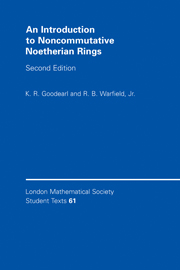Book contents
- Frontmatter
- Contents
- Introduction to the Second Edition
- Introduction to the First Edition
- Prologue
- 1 A Few Noetherian Rings
- 2 Skew Polynomial Rings
- 3 Prime Ideals
- 4 Semisimple Modules, Artinian Modules, and Torsionfree Modules
- 5 Injective Hulls
- 6 Semisimple Rings of Fractions
- 7 Modules over Semiprime Goldie Rings
- 8 Bimodules and Affiliated Prime Ideals
- 9 Fully Bounded Rings
- 10 Rings and Modules of Fractions
- 11 Artinian Quotient Rings
- 12 Links Between Prime Ideals
- 13 The Artin-Rees Property
- 14 Rings Satisfying the Second Layer Condition
- 15 Krull Dimension
- 16 Numbers of Generators of Modules
- 17 Transcendental Division Algebras
- Appendix. Some Test Problems for Noetherian Rings
- Bibliography
- Index
Introduction to the Second Edition
Published online by Cambridge University Press: 11 November 2010
- Frontmatter
- Contents
- Introduction to the Second Edition
- Introduction to the First Edition
- Prologue
- 1 A Few Noetherian Rings
- 2 Skew Polynomial Rings
- 3 Prime Ideals
- 4 Semisimple Modules, Artinian Modules, and Torsionfree Modules
- 5 Injective Hulls
- 6 Semisimple Rings of Fractions
- 7 Modules over Semiprime Goldie Rings
- 8 Bimodules and Affiliated Prime Ideals
- 9 Fully Bounded Rings
- 10 Rings and Modules of Fractions
- 11 Artinian Quotient Rings
- 12 Links Between Prime Ideals
- 13 The Artin-Rees Property
- 14 Rings Satisfying the Second Layer Condition
- 15 Krull Dimension
- 16 Numbers of Generators of Modules
- 17 Transcendental Division Algebras
- Appendix. Some Test Problems for Noetherian Rings
- Bibliography
- Index
Summary
Robert Breckenridge Warfield, Jr. (1940–1989)
Since the publication of the first edition in 1989, this book has been used by several generations of graduate students. From the accumulated comments, it became clear that a number of changes in the presentation of the material would make the book more accessible, particularly to students reading the text on their own. During this same period, the explosive growth of the area of quantum groups provided a large new crop of noetherian rings to be analyzed, and thus gave major impetus to research in noetherian ring theory. While a general development of the theory of quantum groups would not fit into a book of the present scope, many of the basic types of quantum groups are ideally suited as examples on which the concepts and tools developed in the text can be tested. Finally, readers of the first edition found a substantial list of typographical and other minor errors. This revised edition is designed to address all these points. Undoubtedly, however, the retyping of the text in TeX has introduced a new supply of typos for readers' entertainment.
Here is more detail:
Changes to the order and emphasis of topics were based, as mentioned, on the combined experience and comments of numerous students and professors who used the first edition over the past 14 years. In particular, more examples and additional manipulations with specific rings – especially in the early part of the book – were requested.
Information
- Type
- Chapter
- Information
- An Introduction to Noncommutative Noetherian Rings , pp. viii - xPublisher: Cambridge University PressPrint publication year: 2004
